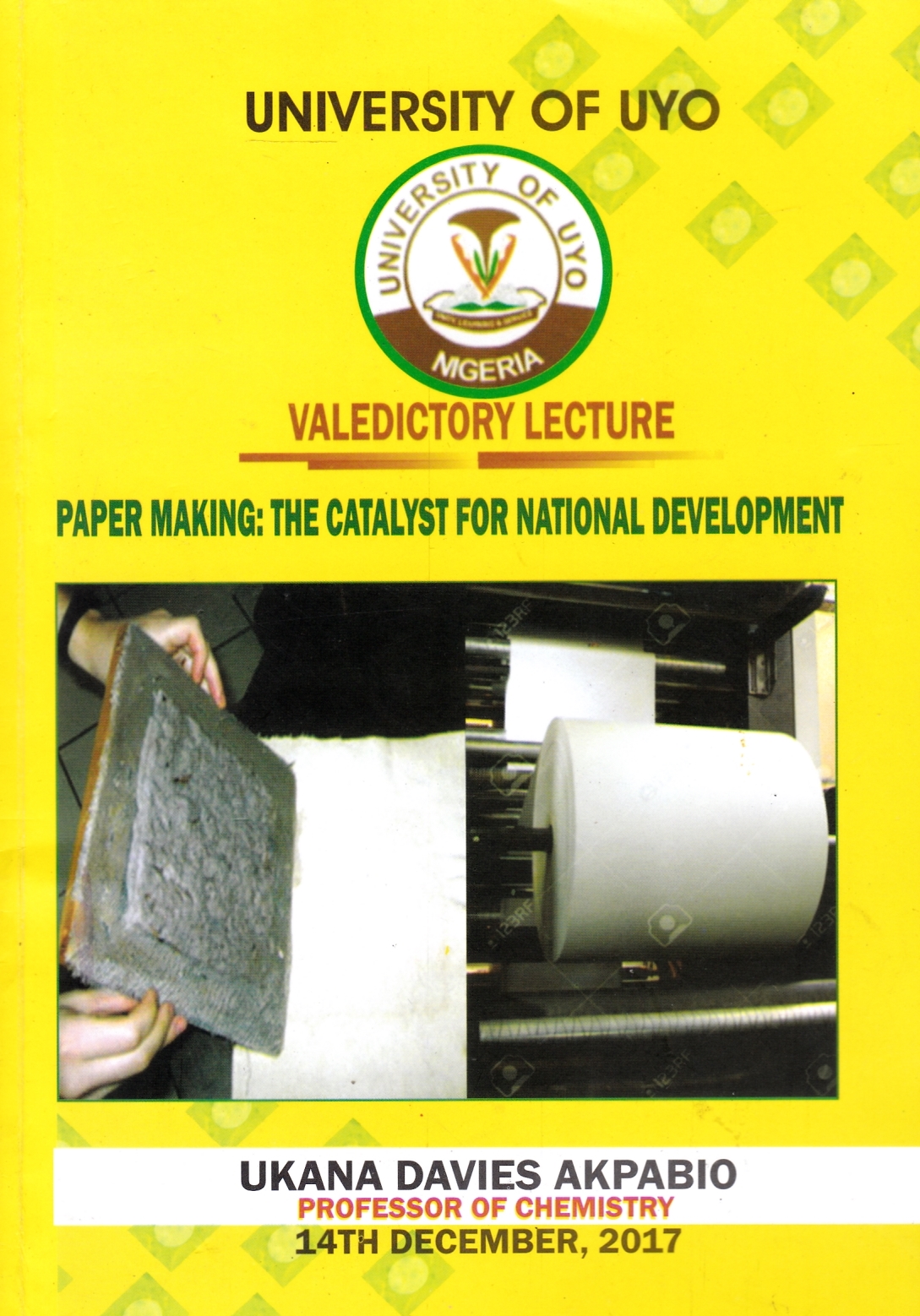Paper Making: The Catalyst For National Development
$5.00
TABLE OF CONTENTS
Portrait of the Lecturer
Title Page
Dedication
Table of Contents
List of Tables
List of Figures
List of Plates
Citation
– Protocol
Appreciation
1.1 Preamble: My Interest in Paper Chemistry
‘2.1 Introduction
2.2 ICT Digital System and Paper Application
2.3 What is Chemistry
2.4 The Focus and Goals of the Lecture
4.1 History of Paper Making
5.1 Pulp and Paper Making Processes
5.2 Raw Materials for Paper Making
5.2.1 The Origin of Paper Making (Cellulosic) Fibre
5.2.2 Structure of Cellulose Fibre
5.2.3 Pulp (Flbres) Production: The Pulping Process
5.2.4 Pulp Bleaching
5.2.5 Paper Making Operations ‘
6.1 Types and Uses of Paper
7.1 Pulp and Paper Industry (PPI) in Nigeria
7.2 Choice of Paper Production Process
Other Products of PPI 43
My Research Works 44
Studies on Suitability of Local Plants (Exotic and Tropical) for Pulp and Paper Making 45
Pulp and Paper from Tropical Pine,
Butyrospermium Parkii and Melina 45
Pulp and Paper from Screw Pine 47
Pulp and Paper from Nypa Palm
Pulp and Paper from Raphia Palm 50
Pulp and Paper from Plantain and
Banana Pseudostem Waste 51
Bonding in Paper 54
Non-Fibrous Paper Making Raw Materials 56
Acid, Neutral and Alkaline Sizing Agents 56
Rosin-Alum and Alkylketene Dimers (AKD)
Exudates from Local PearTree as PaperSizing Agent 62
Mollusk Shells Powders as Fillerand PaperSizing Agent 62
Local Paper Bonding Agents 63
Other Research Works Undertaken ‘ 63
Current Research Works 65
Exhibitions in Science and Technology 68
Application of Research Results _ 71
Planning for a Viable PPI in a Developing Country (Nigeria)71
Paper Making as the Catalyst for National Development 78
imperatives and the Way forward for Developing Paper 82
Making Industry in Nigeria
Conclusion 86
References ‘
Appendix
LIST OF TABLES
TABLE TITLE PAGE
1 Papersizes 25
2 Federal Governmentowned integrated pulp and papermills
3 Newsprint: lmportand local productin Nigeria
4 Types of paper required in Nigeria
5 Waste paperoonsumption peryear in recycling mills in Nigeria
6 Properties of Screw Pine (Pandanus candelabrum) pulp
7 Characteristics of Newsprint and paper made from blended
local pulps
8 Sources of paper pulps in Nigeria
9 Quantity of long and short ?bres by operating mills in Nigeria
10 Percapita consumption of paperand the level of national Development
11 The ?rst ten paper producing countries in the W0|’ld
LIST OF FIGURES
FIGURE TITLE PAGE
1 Molecular Structure of Cellulose 12
2 (a) Hardwood (b) Schematic Representation of Cellulose Stiucture 13
3 Flow Chartfor Paper Making Operations
4 Sections of Fourdrinier Paper Machine
5 Products of Chemical Wood Pulping
6Bonding System in a Sheet of Paper
7Mechanism ofAKD Reaction with Cellulose
8 H-BondedAKD Size on Paper
9 Covalent Bonded AKD Size
10 The First Ten PaperProducing Countries in the World
LIST OF PLATES
PLATE TITLE PAGE
1 Melina Plantation 14
2 Felling Pulpwood Tree
3Debarking and Chipping
4Pile of Wood Chips at a Pulp Mill
5Digesting of Wood Chips
6Unbleached Nypa Pulp
7 Unbleached and Bleached Pulp
8Microscopic View of Unbeaten and Beaten Pulp
Hand Sheet Formation
ARoIl of Machine Made Paper
Pine Trees Produce Long Fllffes
Melina Plantation forShort Fibre Pulp
Screw Pine Trees _
Pieces of Screw Pine Leaves
Nypa Palms _ _
Raphia Palms (Raphia hookeri)
(A) Plantain Plant (B) Transvers Section (C) Pseudostem Filaments
Paper Made from Local Plant
Autographs of Sheets Containing AKD
Liquid Wood Droplets and Granules
Arboform Pen and Pencil Holders d
Pulp, Paperand Publishing Materials Stand at RMRDC Display Centre
Exhibition Stand at NURESDEF, Awka 2016
ukanaakpabio
Questions and Answers
You are not logged in
